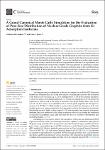A Grand Canonical Monte Carlo Simulation for the Evaluation of Pore Size Distribution of Nuclear-Grade Graphite from Kr Adsorption Isotherms
| dc.contributor.author | Laudone, GM | |
| dc.contributor.author | Jones, KL | |
| dc.date.accessioned | 2023-10-10T15:39:28Z | |
| dc.date.available | 2023-10-10T15:39:28Z | |
| dc.date.issued | 2023 | |
| dc.identifier.issn | 2311-5629 | |
| dc.identifier.issn | 2311-5629 | |
| dc.identifier.other | ARTN 86 | |
| dc.identifier.uri | https://pearl.plymouth.ac.uk/handle/10026.1/21362 | |
| dc.description.abstract |
Characterizing materials with low surface areas or with very small sample sizes requires innovative approaches beyond traditional N2 and Ar adsorption measurements. The measurement of Kr adsorption isotherms is often employed to serve this purpose, yet its potential remains limited by the lack of models for the interpretation of the experimental results in terms of pore size distribution. In this work, simulated adsorption isotherms of Kr onto graphite in slit-shaped pores are generated with a Grand Canonical Monte Carlo method. The pore size distributions of nuclear-grade graphite samples and activated carbon are modelled by fitting simulated isotherms to the experimental data. The resulting distributions are favourably compared with those generated by commercially available modelling packages, based on the use of N2 adsorption isotherms using GCMC and BJH methods. The new GCMC-Kr kernel developed in this study offers an alternative method for the evaluation of the distribution of pore sizes in nuclear graphite and other low surface area materials, which can be employed when N2 and Ar adsorption measurements cannot be carried out. | |
| dc.format.extent | 86-86 | |
| dc.language | en | |
| dc.publisher | MDPI AG | |
| dc.subject | GCMC | |
| dc.subject | nuclear graphite | |
| dc.subject | activated carbon | |
| dc.subject | krypton adsorption | |
| dc.subject | pore size distribution | |
| dc.subject | modelling | |
| dc.title | A Grand Canonical Monte Carlo Simulation for the Evaluation of Pore Size Distribution of Nuclear-Grade Graphite from Kr Adsorption Isotherms | |
| dc.type | journal-article | |
| dc.type | Article | |
| plymouth.issue | 3 | |
| plymouth.volume | 9 | |
| plymouth.publisher-url | http://dx.doi.org/10.3390/c9030086 | |
| plymouth.publication-status | Published online | |
| plymouth.journal | C | |
| dc.identifier.doi | 10.3390/c9030086 | |
| plymouth.organisational-group | |Plymouth | |
| plymouth.organisational-group | |Plymouth|Faculty of Science and Engineering | |
| plymouth.organisational-group | |Plymouth|Faculty of Science and Engineering|School of Geography, Earth and Environmental Sciences | |
| plymouth.organisational-group | |Plymouth|REF 2021 Researchers by UoA | |
| plymouth.organisational-group | |Plymouth|Users by role | |
| plymouth.organisational-group | |Plymouth|Users by role|Academics | |
| plymouth.organisational-group | |Plymouth|REF 2021 Researchers by UoA|UoA07 Earth Systems and Environmental Sciences | |
| dcterms.dateAccepted | 2023-08-23 | |
| dc.date.updated | 2023-10-10T15:39:27Z | |
| dc.rights.embargodate | 2023-10-12 | |
| dc.identifier.eissn | 2311-5629 | |
| rioxxterms.versionofrecord | 10.3390/c9030086 |


